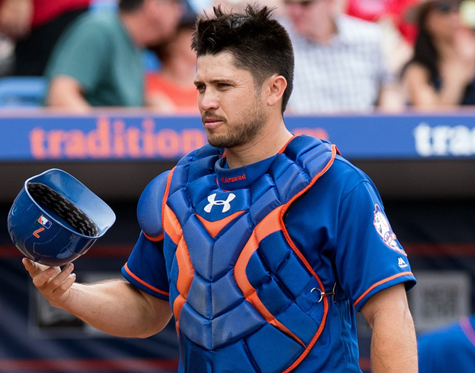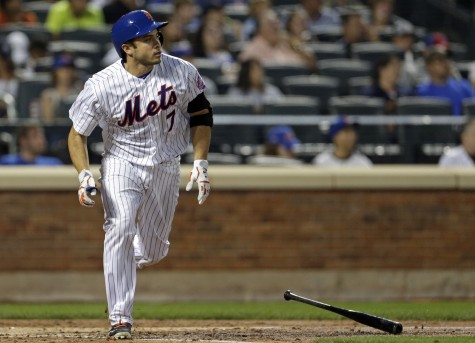
This offseason, the Mets have a number of important decisions to make. However, one avenue they don’t have to address is the catcher position.
One move that fans will have near unanimous agreement with is bringing back Rene Rivera as the Mets backup catcher. Rivera certainly earned his reputation as not only a good defensive catcher, but also one that serves as a mentor for young starting pitching. Much of the unexpected success both Robert Gsellman and Seth Lugo had were partially the result of them working with Rivera. More importantly, Rivera developed a a well documented rapport with Noah Syndergaard and eventually became his personal catcher. We last saw Rivera catching seven brilliant innings from Syndergaard in the Wild Card Game. With Rivera being arbitration eligible, he should be a lock to return in his backup role.
There is no sugar-coating it, the 2016 season was a disaster for Travis d’Arnaud at the plate. In 75 games, he hit just .247/.307/.323 with only four homers and 15 RBI. He didn’t have one extra base hit or an RBI off of a left-handed pitcher the entire season. It was as bad as you can possibly imagine. In fact, his numbers were almost as bad as they were in his 2014 rookie season. That year, the Mets had to send him down to the minors to let him fix his issues at the plate. The Mets couldn’t afford to do that this season.
Making everything all the more frustrating was d’Arnaud regressed in his ability to throw out base runners. In 2015, he was actually league average in that department. That is all the more impressive when you consider how the Mets starting pitchers generally do not hold runners on well. This season d’Arnaud went back to only throwing out 22% of base runners.

Part of his offensive and throwing issues are related to mechanics. Part of them may be related to the rotator cuff strain he had in his throwing shoulder. Another factor was with d’Arnaud struggling and receiving irregular playing time. It could be any combination of the three. In any event, d’Arnaud had a poor year offensively and a poor year throwing.
However, d’Arnaud was still good behind the plate. He’s always been good at fielding a throw and getting the tag down without violating baseball’s new blocking the plate rules. He still calls a good game. He was yet again one of the best pitch framers in baseball. In fact, his teammate. Addison Reed, said of him:
“There’s been a couple of times just this season that I’ve went back and looked at video just because I wanted to see how low the ball was, and how good of a strike (d’Arnaud) made it look. He’s the best I’ve ever thrown to at doing that. Just the way he frames the ball, it’s unbelievable. He makes balls that are four or five inches below the zone look like they’re almost right down the middle by just the way he flicks his wrist. I couldn’t even tell you how he does it.” (ESPN.com)
Judging from Reed’s words, you can tell he also has the confidence of his pitching staff.
With d’Arnaud still excelling behind the plate, and there being valid reasons for his poor performance, it might just be in the Mets’ best interest to bet on d’Arnaud rebounding in 2017. Remember, d’Arnaud was the same player who hit .268/.340/.485 with 12 homers and 41 RBI in 67 games during the 2015 season.
With his skills behind the plate, he has the rare ability to be able to hit and catch well. With him turning 28 years old and still being a player with multiple years of control, the Mets would be best suited to count on him getting healthy in the offseason (not always a given with d’Arnaud) and letting him reclaim his 2015 form.

Another reason to bet on d’Arnaud is the weak free agent class. Looking at the list of possible free agents, there does not exist one catcher who appears to be a better bet than d’Arnaud.
The first catcher most people will point to is Wilson Ramos. Even if you buy into his career year being a new norm for him, Ramos isn’t even sure he will be able to play next season after tearing his ACL. As Ramos said himself, “Unfortunately this injury… may affect whether I am able to stay with a NL team.” That rules out Ramos entirely.
The next catcher that is often mentioned is Matt Wieters. In 2016, despite hitting in a hitter’s park like Camden Yards, Wieters hit .243/.302/.409 with 17 homers and 66 RBI. These numbers are partially why he had an 87 OPS+ meaning he was a subpar offensive player. Even if you are willing to overlook some of these stats because he is a switch hitter, he hit .231/.304/.346 with three homers and 15 RBI off lefties this year.
Moreover, Wieters is nowhere near the pitch framer d’Arnaud is. Wieters is not only unable to steal his staff a strike here or there, he is also unable to ensure that strikes thrown will be called strikes. Another consideration is Wieters is a fairly injury prone player. While he was healthy in 2016, he was not for the previous couple of years. If one of the reasons you are looking to move on from d’Arnaud is health, Wieters is not your guy.
Another reason why the Mets should not pursue Wieters, or whoever else you believe should be a target, is money. Ultimately, players like Wieters are going to cost far more than d’Arnaud. That’s important when you consider Jacob deGrom is heading to his first arbitration year, and the Mets still have to find the money to re-sign Yoenis Cespedes. Any money spent this offseason is presumably less money that will be available to retain Cespedes.
There are no catchers out there who you could point to as an upgrade over d’Arnaud. In fact, most are probably not as good as him. Worse yet, they are going to be more costly. With that in mind, the Mets’ best move would be to let d’Arnaud get healthy so he can contribute to the Mets like he did in 2015. If he doesn’t, the Mets still have Kevin Plawecki…















